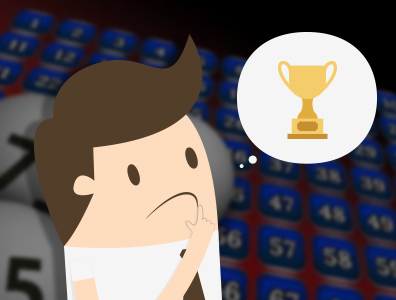Learn to calculate the odds in Keno
The purpose of this video will be to answer the questions:
- What are the rules of keno?
- What are the chances of winning?
- What is the return to player for this bet?

Hi, this is Mike, and you are going to learn to calculate the odds in keno. Keno is a really simple game. To go over the rules real quick, the player picks 2 to 10 number from a range of 1 to 80, after the player is done, the game will pick 20 numbers from that some range of 1 to 80.
The player is paid according to…
…the number of balls that match the player's picks. For example, I picked five numbers, I matched only two of them, so I didn't win anything. If you pick five numbers, you need to match at least three to win anything.
Okay, so that time I matched three of them:the 17, 25, and 56. I won $3 based on a $1 bet, and when I say win, that's what I got back. In keno, all wins are on a "for one" basis, meaning that, even if you win, you don't get back your original bet. So if you won one, it really would be just getting your original bet back like a push.
Click “See Pay”
This will show you the whole pay table according to the number of marks that you picked. For example, if you picked 10 numbers and matched 5 of them, you would win 5. If you matched 6, you would win 24. If you matched 7, 146, and so on.
This game, by the way:
can be found at videopoker.com, and my friends there kindly let me use their game for this video. Let's jump in and show you how to calculate the math.
Before I get into the mathematics of keno
Let me introduce a couple functions that you'll need to understand to go further. One of them is called the factorial function, and that is simply the product of every integer from one to whatever number you're taking a factorial of. For example, five factorial is equal to one, times two, times three, times four, times five, and that equals 120.
What is the practical use of this?
It is simply the number of ways you can order n objects. For example, the number of ways you could order the numbers 1 to 5 is 120.
Next, let's go to the combinations function
This is the number of ways you can pick Y things out of X items. For example, at El Pollo Loco, they have eight side dishes, and you might be allowed to pick three of them.
How many different ways could you pick three out of eight items?

The way you would express that is three choose eight, and the formula there is X factorial, divided by Y factorial, divided by X - Y factorial, where X is the number of items and Y is the number of times you're picking from it.
For example, in the El Pollo Loco example where they have eight side dishes and you can pick three, the number of combinations is eight factorial divided by eight minus three-factorial, which is five factorial, divided by three factorial, which works out to 56, I believe.
For my next example, let's work out the odds in the case of the pick five:
If the player gets all five right, he will win 838. The number of ways that can happen is 20 choose 5, which equals 15,504. The number of ways the player can get four correct, which pays 13, is equal to the number of ways the player can pick 4 out of the 20 winning numbers, or 20 choose 4 times the one way he can pick the losing number. That equals 290,700.
The lowest win is to get three correct out of the five, so the number of combinations of the ways the player can pick three out of the 20 winning numbers is 20 choose 3 times the number of ways the player can pick two out of the 60 losing numbers, and that equals 2,017,800.
Now…
we actually don't need to implicitly calculate the number of losing calculations. Let's just determine the total number of all combinations, winning and losing. That is simply the number of ways the player can pick 5 numbers out of 80 because there are 80 numbers and the player must pick five of them. That equals 24,040,016.
Next, let's multiply the pays by the combinations to get.

Again, the return combinations, or the amount the player will get back if we went through a cycle of all the ways of everything that could happen. 838 times 15,504 is 12,992,352. 13 times 290,700 is 3,779,100. 3 times 2,017,800 is 6,053,400.
We take the total of all these return combinations, and we get 22,824,852. In other words, if the player plays this game 24,040,016, and $1 each time, he could expect to get back $22,824,852. If we calculate his return, that's simply that 22 million figure divided by the 24 million figure, which equals 94.95%.
Another way of expressing that is…
The player can expect to get almost 95% of his money bet, and the other 5.05% is kept by the game or the casino. I should add that this is a very generous paytable here. This is as generous as it gets. Most of the time, the pay table is less, you win less, which goes to show the importance of scouting around for a good pay table.
Finally
Let's look at the odds picked in keno in Excel. The number of ways the player can correctly pick 10 out of 10 equals the number of ways the player can pick 10 numbers out of the 20 drawn by the game, which equals 184,756.
The number of ways the player can get 9 out of 10 right equals 20 choose 9 times 60, for the one incorrect number. A general formula for any number of correct catches is 20 choose the number of those catches times 60 choose the number of incorrect picks, which can be expressed like this here:
We can just copy and paste that down. Let's copy and paste it up as well to see if I did it right. Yes.
I'm not going to bother calculating the number of losing combinations, just the total number of combinations, which is the number of ways the player can pick 10 numbers out of the full 80. The return is the combinations times the win.
Let's copy and paste that down and take the total
If the player played this 1,646,492,110,120 times, he could expect to get back $1,534,456,875,040, on average. What is the value of his bet? Well, let's put that in the percentage. That comes out to 93.2%. In other words, for every dollar the player bets, he can expect to get back 93.2% of it and the other 6.8 percent goes to the casino.
I might remind you, again…
…that not every pay table is this generous. In fact, this is the most generous. Lots of times, this 24 is a 23 or less. This 146 is often less. The big pays tend to be the same, though. Again, I can't emphasize enough, shop around for the good pay tables.
Finally, I hope you'll humor me and let me plug my website here. It has a cornucopia of keno resources starting with this keno game. You can pick 1 to 15 numbers. You can pick the numbers yourself or you can do a quick pick. You can also put it on autoplay.
Besides this, we have a bunch of keno calculators. I'll just show you the one for plain old keno. Let's do that pick 10 paytable I just did. You may recall that getting 10 right pays 10,000. Nine pays 45,000. Eight pays 1,000. Seven pays 146. Six pays 24. Five pays 5. Click calculate and there we see everything. The probability of every win, the frequency, variants. Here we see the return.
The bottom line…
…here is that same 91.2%. I hope you can see that small figure that I showed you how to calculate yourself. I just don't talk about regular keno. I talk about Power Keno, Super Keno, Cleopatra Keno, Caveman Keno, Caveman Keno Plus, Extra Draw Keno, Triple Power Keno.
I indicate resources about the return of every possible game and pay table you may plausibly find here in Las Vegas, keno surveys, who has the best games here in Vegas, and a whole ton of internal links about keno. I say a lot about keno because frankly, the math of it is pretty easy.
All right. I think this video has run long enough. Thanks for watching. I'll see you next time.




